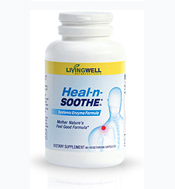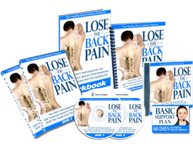Does Back Pain Have You Feeling Depressed?
by Margaret McCraw, Ph.D.
Have you been in a funk, not understanding the reason for your bad moods and lack of energy? Are you isolating yourself from others because you never know how you will feel from moment to moment? Have you noticed that friends and family members have backed away from spending time with you? Is living from day-to-day becoming more and more of a burden, with no light in sight? If you have answered yes to any of these questions, you may be experiencing a medical illness known as depression.
Chronic pain and depression are two of the most common health problems that health professionals encounter, yet only a small percentage of studies have investigated the relationship between these conditions (Currie and Wang, 2004).
Stress and anxiety stemming from chronic pain, is frequently the source causing a major depression. Researchers estimate that depression and anxiety occur in 20% – 50% of patients with chronic pain (source – www.backandneck.about.com). Major depression is thought to be four times greater in people with chronic back pain than in the general population (Sullivan, Reesor, Mikail & Fisher, 1992). In a recent study it was found that the rate of major depression increased in a linear fashion with greater pain severity (Currie and Wang, 2004). It was also found that the combination of chronic back pain and depression was associated with greater disability than either depression or chronic back pain alone.
There are key differences between chronic pain and acute pain. The nervous system processes chronic pain differently that acute or “immediate” pain. Acute pain occurs as a result of an incident or event, e.g. you fall down the steps and sprain your ankle. Chronic or “long term” pain happens over time and wears on the individual physically, emotionally, mentally and spiritually, often with no end in sight, causing the individual to feel more and more pessimistic. Pessimism is a persistent negative thought pattern, resulting in a sense of hopelessness, and severely damaging ones sense of well-being. Our emotions stem from our thoughts. When our “habit of thought” is negative, our emotions spiral downward, lowering our mood, energy level and spirit. In my opinion, depression, simply put, is an extension of pessimism.
The first step in changing these thought patterns and associated emotions is to understand what you are going through when experiencing a depression. The good news is you have the ability to make changes that will affect the way you feel and experience life on a day-to-day basis. Are you ready to release the depression and re-experience having fun, laughter and pleasure with your family and friends? Of course you are, so read on to begin shifting your life in an upward and more positive direction.
WHAT IS A DEPRESSIVE DISORDER?
A depressive disorder is an illness that involves the whole person; mind, body, spirit and emotions. It affects the way a person perceives himself as well as his perceptions of the world, resulting in pessimism, hopelessness, sadness and often times anxiety. Depression associated with chronic pain often stems from fear of not knowing how you will feel from moment-to-moment.
Common Myths about depression:
Depression:
- is a personal weakness
- reflects laziness or unwillingness to actively participate in life.
- is a diagnosis that is untreatable and incurable
These myths are unfounded and represent the opposite of the truth about depression.
HOW WIDESPREAD IS DEPRESSION IN THE UNITED STATES?
Depression affects men and women, young and old and individuals of all races, cultures, religions and incomes. Depression can occur at any age. Studies sponsored by the National Institute of Mental Health (NIMH) estimate that approximately 6 percent of children ages 9 to 17 in the U.S., and 10 percent of American adults, or about 19 million people ages 18 and above, experience some form of depression every year. Although available therapies alleviate symptoms of depression in over 80 percent of those treated, less than half of these individuals receive medical intervention (NIMH fact sheet on depression and cancer, 2002).
WHAT IS THE PERSONAL IMPACT OF DEPRESSION?
Depression:
- is one of the most common psychological problems, affecting nearly everyone through either personal experience or through association with a depressed family member or close friend
- often causes insomnia, leading to fatigue, and agitation
- often leads to social isolation
- frequently leads to less participation in life and less enjoyment of meaningful activities
- can lead to job dysfunction and inability to work, causing financial difficulties
- coupled with chronic back pain may cause gastrointestinal distress caused by anti-inflammatory medication, resulting in a feeling of mental “dullness”
- can create memory and concentration difficulties
- can cause a lack of interest in sexual activity, creating stress in one’s intimate relationships
- can interfere with significant relationships with family, friends, business associates, neighbors and co-workers
- can limit one’s ability to do household chores and care-taking of young children, resulting in spouses and older children taking over responsibilities that were once managed by the individual with depression and back pain
WHAT IS THE SOCIETAL IMPACT OF DEPRESSION?
Depression:
- is directly experienced by approximately 19 million American adults (many children also experience depression)
- adversely affects the lives of 10% of the American population (source: Donald J. Franklin, Ph.D., www.psychologyinfo.com/depression)
- intrudes upon the lives of millions of people throughout the world
- is the leading cause of disability among developed nations, including the United States ( source: U.S. Department of Health and Human Services, Mental Health: A Report of the Surgeon General – Executive Summary, 1999)
- often reduces work productivity, attendance, efficiency and overall job effectiveness. The pessimism experienced by a depressed individual often leads to a lack of commitment, enthusiasm and ability to address details, which may lower the quality of one’s work
- lowers productivity and impacts our economy, resulting in an estimated $44 billion a year loss (source: Donald J. Franklin, Ph.D., www.psychologyinfo.com/depression)
ARE YOU DEPRESSED?
It is important to understand that depression and sadness are different. The death of a loved one, loss of a relationship, termination of a job, including retirement, will cause us to feel sad. Grief is a normal response to these situations. Individuals experiencing challenging times will often remark that he or she feels depressed. However, sadness, grief and depression are not the same. Feelings of sadness and grief will lessen with time while depression can continue for months and years, if untreated.
Does this seem like you?
Read the following list and put a check mark next to each symptom that you are experiencing:
- I am really sad most of the time
- I don’t enjoy doing the things I’ve always enjoyed doing
- I have difficulty sleeping at night
- I often feel fatigued
- Getting up in the morning is challenging.
- I feel better as the day goes on compared to when I first awoke
- My eating habits have changed: Generally, I eat more than usual or I eat less than usual
- I have very little, if any, sexual energy
- I am very forgetful throughout the day
- I find it hard to focus on the simple things of life. Even counting change has become challenging
- I often feel angry
- I feel anxious, and fearful with no apparent reason
- I prefer to stay alone rather than socialize
- I feel pessimistic about life in general, and am not sure I want to continue living
- I feel disappointed in myself
- I feel bad (physically and emotionally) most of the time
- I have thoughts about my death
- I think about how I might kill myself
If you checked any of these boxes, call your doctor. Take the list to your physician and discuss options for treatment, if necessary.
Note: Source for list – National Institute of Mental Health/NIMH; some of the items in this list have been slightly revised; new items have been added from the original list provided by NIH.
WHAT SHOULD I DO IF I THINK I AM CLINICALLY DEPRESSED?
Step #1: If you are feeling like hurting yourself or someone else then get professional help immediately. Call 911 or ask a friend or family member to take you to the emergency department of the nearest hospital. Contact your physician immediately. Do not wait until the next working day to reach your physician.
Step #2: Understand that depression is a serious medical illness involving the brain, which impacts your functioning. Depression can happen to anyone, regardless of your age, race, sex, religion, culture or socio economic status. Accept this illness without self-judgment so you can take the proper steps to get better.
Step #3: Get a medical checkup to rule out other health problems causing or contributing to the depression. If you are clinically depressed, request the doctor to refer you for professional help to treat the depression. There are two main treatments for depression: medicine (known as antidepressants) and “talk” therapy. Many individuals benefit from both treatments over a period of time.
Step #4: Follow through with treatment as recommended by a knowledgeable professional. Be in charge of your well-being by speaking up and addressing any concerns with your physician and/or therapist. It is important that you feel comfortable with the treatment plan in order to embrace getting well.
HOW IS DEPRESSION TREATED?
The person experiencing chronic pain often assumes that depression comes with the territory, and is untreatable. He or she “buys into” the myth that as long as they are experiencing chronic pain they must endure depression. However, back pain and depression are separate entities requiring different treatment modalities. It is important to understand that depression is treatable. With the proper measures, you may be alleviated of your symptoms, giving you the freedom to more fully participate in day-to-day activities, and to enjoy life.
Therapies include medication and talk therapy:
Medicine: Antidepressants may take several weeks before you begin to feel better. There are many different types of antidepressants and often the doctor must try several different types of medication before striking the right balance for you. It will be important that you stay in close contact with your physician and let him/her know how you are feeling. If you are feeling side effects such as nausea, blurred vision, fatigue, etc., you will want to bring this to the attention of your physician.
Talk therapy: Talk therapy involves participating in counseling sessions with an appropriate licensed professional such as a social worker, psychologist, psychiatric nurse or psychiatrist. Talk therapy helps you to change the way you think, feel and behave to support you in feeling better. Talk therapies that have been known to help with depression include cognitive therapy and interpersonal therapy or some combination of both forms of intervention. Cognitive therapy focuses on thought patterns, feelings and behaviors while interpersonal therapy addresses challenges in relationships.
WHAT CAN I DO TO FEEL BETTER?
A four-step plan to enjoy life and find fulfillment is outlined in my book, Tune Into Love. Here you will find “love boosters” to help you release fear and anxiety, which contributes and exacerbates depression. While this book is written to help individuals to attract their ideal intimate relationship, you will find that the four step plan outlined in my book can be used to create better health, better relationships, a more fulfilling career and prosperity of all kinds.
These four steps include:
Step one: Create “feel good” moments – Learn how to sooth yourself and minimize the impact of ruffled feathers (yours or someone else’s) when stressful events occur. Understand how pets, friends and loved ones can help you create “feel good moments”. Learn how to identify and side-step barriers which may impact your own sense of well-being. Transcend these barriers through the process of reframing or restructuring your thoughts. Develop a gratitude list and add to this list daily to enhance your personal power and ability to feel good. Understand why gratitude is a thought pattern that can uplift you quickly and shift your emotional response to pain.
Step two: Identify your desires (desires such as “I want to feel better”) – Learn to focus attention on what you want rather than the fear of not having what you desire (focus on feeling good rather than feeling bad). For instance, you can give attention to your pain by talking about it; however, research has shown that focusing on what we don’t want can cause us to feel worse. It is better to give attention to the positive by saying, I want to “feel good”, rather than I don’t want to “feel bad”. In essence, whatever we give attention to becomes our experience.
Step three: Activate your intentions (intentions are strong desires coupled with strong belief that you can have what you want) – The more positive emotion we experience when thinking about a desire, the more likely we are to create it. Our bodies respond positively to positive emotion and negatively to negative emotion. Let yourself feel the full range of emotions, and then make an effort to shift your thoughts to a more optimistic perspective. Your body will respond accordingly over time. Whenever we place our peace of mind or happiness on hold waiting to feel better, that day never comes. Begin now to activate your intentions by taking steps toward living the life you desire. Start participating in activities that are in alignment with your doctor’s medical advice. Make an effort to be uplifting to yourself and others. You will find that in time you will feel better emotionally by letting go of being a victim to your pain.
Step four: Release the outcome – Believe that you can release the depression and you will respond better to therapeutic interventions. Research demonstrates that depression is a highly treatable diagnosis. Stay focused on this truth and you will more quickly enhance your own sense of well-being. Stay optimistic and refuse to give attention to what you don’t want (pain) and focus attention on your desire to feel well.
TIPS FOR DAY-TO-DAY LIVING WHILE MOVING THROUGH A DEPRESSION
- Set reasonable goals for yourself
- Set priorities and do what you can
- Break large tasks into small ones
- Take everything at your own pace
- Stay connected with others through phone conversations and activities that are appropriate for your health.
- Walk, walk, walk if acceptable to your physician. Walk at your own pace. Short, easy walks may help change your body chemistry to support you in feeling better. Try engaging in any mild exercise that has been approved by your physician.
- Remember that feeling better is a process and it takes time. Be patient with yourself.
- Practice the art of forgiving. Release judgment of yourself and others. Stop seeing things as “right or wrong”, “black or white.” Release the “shoulds” in your life and let yourself be inspired into action.
- Shift pessimistic thinking to hopeful thoughts. Ask friends and family who you trust to help you look at situations optimistically.
- Remember to focus on the good things in life and practice seeing every situation from love rather than fear.
WHERE CAN I GET HELP?
Information and referrals for help with depression:
- National Alliance for the Mentally Ill (NAMI)
- National Mental Health Association (NMHA)
- National Institute of Mental Health
- American Psychiatric Association (APA)
- Depression and Bipolar Support Alliance (DBSA)
- National Association of Social Workers
- Self-help books
- National Depressive and Manic-Depressive Association
- John’s Hopkins InteliHealth
- Psychology Information Online (how to find a therapist)
- Support groups for depression (search the internet for a group close to where you live)
HOW CAN I HELP A DEPRESSED PERSON?
There are several ways to support someone you know, who may be depressed:
- Understand that depression is a medical diagnosis and release myths about it representing laziness, personal weakness or that it is untreatable
- Offer compassion and empathy rather than sympathy. Be understanding,;patient, and encouraging.
- Engage the depressed person in conversation, and do more listening than ;talking. Offer hope and respond to him with optimism.
- Do not ignore remarks about suicide or remarks about wanting to hurt someone else. These remarks should be reported to an appropriate licensed professional.
- Invite the depressed person to participate in activities appropriate for his health, which may include going for walks, outings, movies, religious activities, hobbies, etc.
- See the person as strong and believe that he or she can transcend the illness. Your confidence in him will support the depressed person in tuning into his well-being.
- Encourage the person to get treatment and to stay in treatment per his doctor’s recommendations
- Accompany the individual for an appointment with his doctor, if he would like you to support him in this way
- When appropriate, assess and monitor if the depressed person is taking medication as prescribed
- Keep reassuring the depressed person that healing is part of a process, and that with time, and with treatment, he will feel better.
- Consider participating in couple, family and/or group therapy with a licensed therapist
© 2006 by Margaret McCraw, Ph.D., author of Tune Into Love
 Margaret McCraw, Ph.D.
Margaret McCraw, Ph.D.
A licensed psychotherapist and motivational speaker, Margaret McCraw, Ph.D., LCSW-C, MBA, provides personal as well as executive coaching and training to a wide variety of organizations and professionals. In addition, as a faculty member of the American Holistic University, Margaret teaches in the doctoral program for Psychology.
With more than 25 years of experience as a therapist, healthcare and business consultant, she works with psychologists, marriage/ relationship therapists, social workers, nurses, mental health counselors, and life coaches. Her seminars focus on raising one’s level of awareness, enabling individuals, couples and organizations to achieve their desires. An inspiring speaker, she travels nationwide, sharing her insights on personal empowerment, manifesting one’s dreams, relationship building and business development.
Margaret McCraw, Ph.D. can be reached for private phone consultations through her web site at www.tuneintolove.com or by calling 1-(877)-366-9111
All consultations are by appointment only!
Top Recommendations
Here are the Top Recommended Solutions for Back and Neck Pain

Natural Pain Reliever delivers instant relief from chronic pain! This pain fighting formula penetrates deep into your muscle tissue and repairs damage to your body's cells - where all of your muscle pain starts. Proven to be 100% Effective, Rub it on and the pain is gone!
Click Here to Learn More
Heal-n-Soothe™ is a combination of the most powerful natural anti-inflammatory and pain relieving ingredients known to man... and have been scientifically proven to work. And unlike NSAID's, there are no dangerous side effects..
Click Here to Learn More
Get rid of your back-pain for good. Join over 56,712 people who've erased back pain and sciatica from their lives. This complete back pain relief system will show you how to identify the true cause of your pain, and get lasting relief once and for all!
Click Here to Learn More
